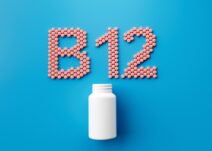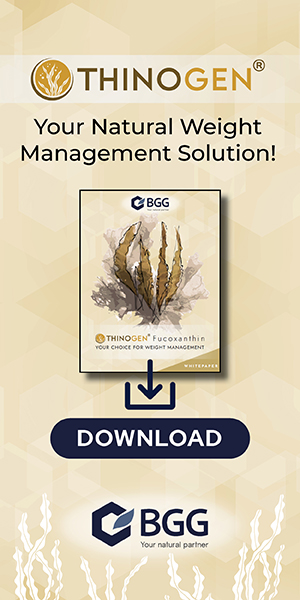Athletes, weekend warriors, and everyday consumers have redefined the expectations about aging. It is no longer just about living longer—it’s about fueling the body correctly and adopting the appropriate training regiment to feel your very best with every passing year. Dubbed “active aging” by the World Health Organization during the late 1990s, wellness brands began tracking consumer sentiments towards longevity and noticed a repositioning with regard to lifespan and enhanced quality of life. Fast forward to 2020, when Grand View Research valued the global anti-aging products market size at USD $40.49 billion with an expected compound annual growth rate (CAGR) of 5.4% from 2021 to 2028, and you have a booming business opportunity within the natural products space.
What does that mean in 2025? What does the landscape look like? With so much potential for growth, how has the rise of technology impacted the next wave of product development? We invited industry insiders to weigh in on today’s disruptors and catalysts, and offer predictions for what’s to come.
Rapid Evolution
The active aging industry has undergone significant change in a short amount of time due in part to drastic increases in the aging population and their overall changing views on fitness and wellness. “With 1.6 billion people expected to be over 65 by 2050, the focus is shifting beyond just lifespan to healthspan—ensuring those extra years are spent in good health,” explains Sevanti Mehta, President of Unibar Corporation. “While life expectancy has increased by 20 years since the 1960s, many still face a decade or more of poor health, according to the McKinsey Health Institute. This reality is driving consumers to take action, with dietary supplements ranking third—behind only diet and exercise—as essential tools for longevity.”
More consumers focusing on the space means increased ability to change the negative narrative typically associated with aging. “The current landscape for active aging and support is evolving rapidly, reflecting broader societal shifts toward health, wellness, and longevity,” says Silvi Siddhu, Global Director of Nutraceuticals for Univar Solutions. “The approach is shifting away from viewing active aging as a challenge and recognizing it as a dynamic opportunity.”
Within the space, Mehta has noticed shifts in consumer expectations. “The active aging supplement market is experiencing significant growth, with the Nutrition Business Journal’s Longevity report projecting it to surpass $1 billion by 2026 and to outpace overall supplement industry growth (7.7% vs. 5.3%). This expansion is fueled by rising consumer awareness and demand for products supporting bone health, joint health, skin health, cognitive function, muscle maintenance, and vision health. Brands are responding by launching new products and repositioning existing formulas with healthy aging claims, as evidenced by a 9% increase in food and beverage launches with healthy aging claims over the past five years. This rise also signals a shift in consumer expectations, with many seeking functional benefits from everyday foods.”
The cornerstone for active aging is active nutrition, says Susan Hamrahi, ND, Scientific Communications Specialist at AstaReal USA. “Active nutrition defines a proactive approach to maintaining health and vitality through a well-balanced diet and lifestyle interventions. It is about optimizing physical and mental performance as we age, staying energetic, agile, and mentally sharp, rather than merely avoiding illness. As research has evolved and the understanding of aging has deepened, so has the approach. It is an opportunity to maintain and even improve one’s health and wellbeing. This approach involves not only dietary intake, but also leveraging supplements to address nutritional gaps that may arise due to age-related factors.”
Part of the market’s development has also involved the widening of the age range of consumers concerned with addressing issues that come with aging. Angie Rimel, Marketing Communications Manager, North American, GELITA, notes that healthy aging is on the minds of every generation. “Healthy aging is important to consumers of all ages, and the concept has expanded to encompass a range of wellness aspects that can be interdependent,” Rimel explains. “Brand owners are developing products that address the multiple health concerns— such as immunity, gut health, heart health, energy, or bone and joint health—simultaneously rather than just focusing on one aspect of healthy aging. The products reflect a more holistic approach to aging. Collagen, for example, is known for skin and joint support and partners well in formulations with other ingredients.”
Siddhu doubled down on the sentiment, explaining: “Companies are adapting to the active aging demographic by broadening their target audience, focusing on preventative health, integrating technology for personalized solutions, and emphasizing holistic wellness and sustainability in their product offerings. Brands have seen the market shift from serving the elderly to a much more comprehensive age range. Products aimed at active aging now cater to a broader age range, recognizing that habits formed in younger years can significantly impact health later in life.”
This shift has expanded the market beyond just the elderly to include younger consumers who are proactive about their future health, Siddhu adds. “Younger generations recognize that mobility and bone health are vastly improved by lifestyle and nutritional choices leading up to their senior years. So we see a growing emphasis on products that support preventative health and are designed to maintain wellness over time, such as supplements for bone health, joint support, and cognitive function as well as functional foods and beverages. Consumers of all ages are transitioning from a lifespan focus to a healthspan mentality and investment. Companies should consider investing in generating social awareness to position aging as an opportunity and not a decline.”
One Size Does Not Fit All
The natural products industry, as a whole, has felt and adapted to the influence of “the educated consumer.” Brands now find themselves emphasizing product transparency, focusing on preventative health, promoting personalized solutions, embracing holistic wellness, and developing information to help their well-informed consumers find the health solutions they need.
“We see a growing emphasis on personalized approaches to health and wellness that encompass a variety of strategies,” says Siddhu. As understanding deepens that no two individuals age in the same way, personalized nutrition and wellness plans that factor in a balanced lifestyle and mindfulness practices have become more popular. These plans consider an individual’s genetic makeup, lifestyle, and health goals to create tailored recommendations that support active aging, rather than following a one-size-fits-all model.”
The healthy aging business has benefited greatly from the growth of personalized products. “Personalized nutrition for active aging is an emerging trend that is becoming a key part of promoting healthy aging,” shares Hamrahi. “By tailoring dietary recommendations to individual needs based on genetics, lifestyle, health status, and personal preferences, personalized nutrition aims to optimize health outcomes for older adults.”
Lauren Clardy, Senior Director of Branded Ingredients, Maypro, explains how companies are using personalization to create uniquely designed products: “In the context of aging, we can tailor dietary supplements and functional foods to an individual’s genetic makeup. Brands are now developing personalized nutrition products based on genetic testing to address specific health concerns like cognitive decline, heart health, and immune function. This innovation enables older adults to optimize their diet and supplement intake based on their unique genetic predispositions, improving overall health and reducing the risk of age-related diseases.”
Merging Science and Tech
With so much advancement taking place, R&D departments are hard at work improving existing products to keep up with the current changes in consumer focus and solving how to use the latest science and technology to develop their future offerings and cater to the trends of tomorrow. Siddhu points to three keywords heavily influencing product development: Technology Integration, innovation, and biohacking. “Beyond nutrition and supplementation, wearable devices, health apps, and data-driven technologies are becoming integral to monitoring and promoting active aging. These technologies track physical activity, sleep patterns, heart rate, and more, providing data that can be used to adjust daily habits for improved health outcomes. We’re also seeing telehealth services making it easier for older adults to access health care professionals from the comfort of their homes, enhancing the support available for active aging.
Bbiohacking is a trend that continues to gain traction, as people aim to optimize their health through lifestyle changes and scientifically backed interventions, Siddhu says. "From nootropics for cognitive enhancement to intermittent fasting for metabolic health, biohacking represents a proactive approach to extending health span and improving quality of life throughout the aging process."
There’s also a growing awareness of the interconnectedness of human health, animal health, and environmental health. Siddhu points to the "One Health" approach. This advocates for a holistic strategy to wellness that includes sustainable living practices, conservation efforts, and diets that minimize environmental impact. Each of these contributes to a healthier planet, healthier individuals, and improved quality of life.
Products and services that can assist consumers on their longevity journeys are seeing the biggest spike in interest from the market. Case and point: wearable tech. “Today’s primary active aging demographic are the Boomers, closely followed by Generation X. As these populations become increasingly aware of their mortality, they tend to place importance on maintaining their independence, health, and quality of life. Their shopping habits shift towards products and services that cater to these goals and, importantly, their goals are increasingly ambitious— driving product innovation,” says Clardy. “The older demographic is further embracing wearables and smart technology, such as fitness trackers and blood pressure and glucose monitors. The devices allow for accurate monitoring of sleep, movement, heart rate and more to proactively support and maintain an active lifestyle. Wearable tech is already being leveraged in partnership with exercise and nutrition programs. The next evolution of it will be data processing to easily provide personalized health insights and custom supplement recommendations.”
the market. Case and point: wearable tech. “Today’s primary active aging demographic are the Boomers, closely followed by Generation X. As these populations become increasingly aware of their mortality, they tend to place importance on maintaining their independence, health, and quality of life. Their shopping habits shift towards products and services that cater to these goals and, importantly, their goals are increasingly ambitious— driving product innovation,” says Clardy. “The older demographic is further embracing wearables and smart technology, such as fitness trackers and blood pressure and glucose monitors. The devices allow for accurate monitoring of sleep, movement, heart rate and more to proactively support and maintain an active lifestyle. Wearable tech is already being leveraged in partnership with exercise and nutrition programs. The next evolution of it will be data processing to easily provide personalized health insights and custom supplement recommendations.”
Still, the new level of consumer expectation has created something of a questionable energy, maintains Mark LeDoux, Chairman and CEO, Natural Alternatives International, Inc. “The current landscape for the area of ‘active aging’ is somewhat confused. People are constantly bombarded with disparate messages extolling them to focus on physical health and fitness while remaining committed to social engagement, pursue intellectual stimulus, ensure financial security and stability, and cultivate an emotional and spiritual connection to their families and community. Depending on one’s age and overall metabolic condition, these admonitions can lead to frustration when ‘perfection’ is not attainable under any circumstance.”
On the horizon...
The March issue of WholeFoods magazine featured Weighing the GLP-1 Effect on Weight Management, a story discussing the effects of GLP-1 on the weight management sector and ushering in the "Ozempic Era." The active aging sector has followed suit and also entered that era with product developers tailoring their offerings to the research surrounding the popular weight loss drug, "The 'Ozempic era' is driving exciting new research into GLP-1 and its broader role in healthy aging," shared Mehta. "While currently targeted for blood glucose and weight management, new findings suggest GLP-1 receptor activation may also boost mitochondrial function, support cognitive health, and assist with maintaining healthy levels of inflammation, all key factors in aging. As this research evolves, we can expect an influx of GLP-1-targeted supplements addressing healthy conditions beyond those associated with metabolic health."
 Acknowledging the GLP-1 influence but emphasizing that more research is needed, Kyle Krause, Regional Product Manager, Functional Fiber and Functional Carbohydrates, BENEO, says, “The GLP-1 trend in the U.S. extends beyond weight management influencing other areas like ageing and longevity. Recent studies suggest that GLP-1 receptor agonists may contribute to healthier aging by reducing mortality risk from certain conditions, such as cardiovascular events, and improving metabolic health. While these findings are promising, dedicated clinical trials specifically examining GLP-1 agonists for longevity are still needed.”
Acknowledging the GLP-1 influence but emphasizing that more research is needed, Kyle Krause, Regional Product Manager, Functional Fiber and Functional Carbohydrates, BENEO, says, “The GLP-1 trend in the U.S. extends beyond weight management influencing other areas like ageing and longevity. Recent studies suggest that GLP-1 receptor agonists may contribute to healthier aging by reducing mortality risk from certain conditions, such as cardiovascular events, and improving metabolic health. While these findings are promising, dedicated clinical trials specifically examining GLP-1 agonists for longevity are still needed.”
With information and trends developing more and more frequently, knowing which SKUs to keep stocked can pose a real challenge for retailers. Back in December, our guide to Mastering the Active Aging Market featured members from SPINS, ITC, Move Nutrition, and others discussing the latest science and products for active aging while offering key insights on how to take full advantage of the booming space. Siddhu says retailers should be paying attention to products that incorporate developing science, "Recent scientific advancements and innovations are significantly shaping product development themes in the active aging space, with increased attention around modulating mitochondrial and cellular functions, which play pivotal roles in the aging process. Products aimed at boosting mitochondrial efficiency and protecting cells from oxidative stress are becoming more prevalent. As research continues to uncover how diet and supplementation influence the hallmarks of aging—many of which are interrelated—our understanding of critical ingredients and products for active aging continues to evolve."
Modulating mitochondrial and cellular functions has also brought products like TriNutra’s ThymoQuin to the forefront of the active aging market, “A recent study by TriNutra has shown that its premium USP-grade black seed oil, ThymoQuin, lowers cortisol levels by more than 40% within four weeks of supplementation,” explains Dr. Liki von Oppen-Bezalel, Business Development Director, TriNutra. “Previously, ThymoQuinone showed benefits within other hallmarks of aging such as improved mitochondrial functions, reduced inflammation, oxidation and overall stress.”
Given the market's current trajectory, consumers should be gearing up for several more waves of active aging product innovation. LeDoux says, “Life extension is no longer a myth, but a real possibility, and further work is underway.”
Undoubtedly, the continuation and usage of research development will propel production, Siddhu says. “As research delves deeper into the biological hallmarks of aging, innovative products are being developed to target these specific areas, such as telomere protection, inflammation reduction, and improved nutrient sensing.” WF










